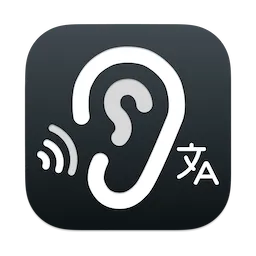I work with colleagues across three continents, and language barriers occasionally crop up during video calls. Even when everyone speaks English, accents and audio quality issues can make following along challenging. I was searching for a transcription solution when I stumbled upon Be My Ears - an app originally created for hearing-impaired users that turned out to be incredibly useful for international remote work.
Be My Ears provides system-wide live captions for any audio playing on your Mac. The app captures sound from your Mac’s speaker and converts it into real-time subtitles, working with Zoom, Teams, Google Meet, Skype, web browsers, and essentially any application that produces audio. This universal compatibility is what sets it apart from meeting-specific transcription tools.
What makes Be My Ears remarkable is its commitment to privacy. Everything runs on-device using Apple’s CoreML and Speech framework. Your audio never gets uploaded to external servers, which is crucial when handling confidential business conversations. The transcription happens entirely on your Mac using Apple’s machine learning models.
The multilingual support is extensive, covering over 20 languages including Chinese (Simplified and Traditional), English (American, British, and Indian variants), French, German, Italian, Japanese, Korean, Portuguese, Spanish, Russian, Arabic, and more. The app automatically detects the language being spoken, which has been incredibly helpful during meetings where team members occasionally switch between languages.
For macOS 15 Sequoia users, Be My Ears offers real-time on-device translation. This feature translates live audio into your chosen language with sub-second delay, all without internet connectivity. I’ve tested this during meetings with international colleagues, and watching real-time translations appear as they speak in their native language feels almost magical.
I’ve been running Be My Ears on my M2 MacBook Air for the past few weeks. The app sits quietly in your menu bar until you need it. The interface is clean and unobtrusive, with a floating caption window that you can position anywhere on screen. The subtitles appear with minimal delay, typically less than a second after the words are spoken.
Beyond live captions, the app can record and export both transcriptions and audio. This has become invaluable for capturing meeting notes and archiving important discussions. The exported audio saves in M4A format, making it easy to share or store for later review.
One unique feature I appreciate is the “Ears Care” function. The app monitors audio levels and kindly reminds you when sound is too loud, helping protect your hearing health. It’s a thoughtful addition that reflects the developer’s focus on accessibility and user wellbeing.
The setup process requires a one-time download of Apple’s language models for your chosen languages. This happens automatically in the background the first time you use the app, though it can take up to 30 minutes depending on your internet connection. The developer is transparent about this requirement in the FAQ, recommending patience and possibly a system reboot if downloads seem stuck.
System requirements are straightforward: macOS 13.0 Ventura or newer, with optimization for Apple Silicon’s Neural Engine. The app works best on M1, M2, M3, or newer Macs, though Intel-based Macs are supported on compatible macOS versions.
The free version provides unlimited core transcription with no time limits, which is remarkably generous for an accessibility-focused app. There’s no freemium trickery or artificial limitations. The developer, Hangzhou Duoziwei Technology, clearly built this to help people first and monetize second.
Be My Ears maintains an impressive 4.7-star rating on the Mac App Store with consistently positive reviews praising its accuracy and privacy approach. Users particularly highlight its value for language learning, accessibility needs, and international communication.
The only limitation I’ve encountered is the initial language model download requirement. If you frequently work with multiple languages, each model needs its own download. However, once installed, everything runs offline without any dependencies on external services.
The story behind Be My Ears is worth sharing. The developer created it after working with a hearing-impaired colleague for eight years. When he shared a video link that wasn’t subtitled, he realized his unintentional lack of consideration and decided to build something to help. That empathy-driven origin shows in every aspect of the app’s design.
For anyone who takes regular video calls, works with international teams, is learning new languages, or needs accessibility support, Be My Ears provides an elegant solution that respects your privacy while delivering genuinely useful functionality. The fact that it’s free makes it an obvious addition to any Mac menu bar.
